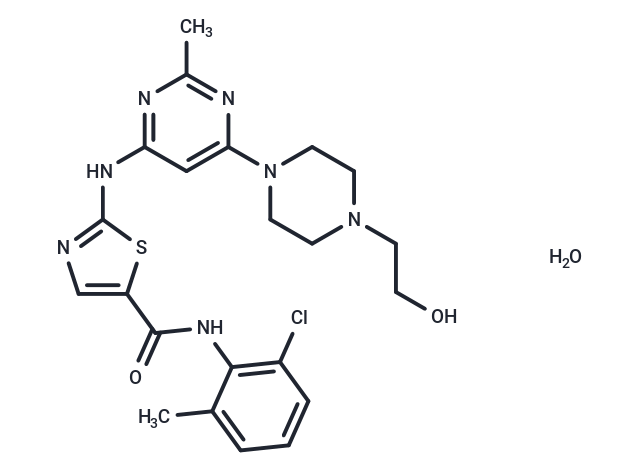Shopping Cart
- Remove All

Your shopping cart is currently empty


| Pack Size | Price | Availability | Quantity |
|---|---|---|---|
| 50 mg | $33 | In Stock | |
| 100 mg | $50 | In Stock | |
| 200 mg | $66 | In Stock | |
| 500 mg | $106 | In Stock | |
| 1 mL x 10 mM (in DMSO) | $40 | In Stock |
| Description | Dasatinib monohydrate (BMS-354825 Monohydrate) is an orally bioavailable synthetic small molecule-inhibitor of SRC-family protein-tyrosine kinases. Dasatinib monohydrate binds to and inhibits the growth-promoting activities of these kinases. Apparently, because of its less stringent binding affinity for the BCR-ABL kinase, Dasatinib monohydrate has been shown to overcome the resistance to imatinib of chronic myeloid leukemia (CML) cells harboring BCR-ABL kinase domain point mutations. |
| In vitro | In TgE mice, Dasatinib specifically inhibits the formation of bone marrow B-cell colonies expressing LMP2A and reduces spleen size. Compared to the control Tg6/λ-MYC mice, the Dasatinib-treated group exhibited significantly smaller spleen masses. Dasatinib also suppresses lymph node enlargement in MYC/LMP2A double transgenic mice and reverses splenomegaly. When tumor cells from LMP2A/MYC double transgenic mice are transplanted into Rag1KO mice, Dasatinib can reverse the splenomegaly. Additionally, Dasatinib inhibits Lyn phosphorylation in B lymphoma cells expressing LMP2A. |
| In vivo | Dasatinib effectively inhibits wild-type Abl kinase and all its mutants (except T315I) by directly targeting all mutant Abl kinase domains and inhibiting substrate and autophosphorylation in a concentration-dependent manner. Compared to Imatinib, Dasatinib demonstrates enhanced inhibitory efficacy on the proliferation of Ba/F3 cells expressing Bcr-Abl (wild-type and all mutants except T315I), exhibiting 325 times the potency against cells expressing wild-type Bcr-Abl. After treatment with Dasatinib, the percentage of the TgE bone marrow cell colonies was reduced from 100% to 4.12%. There's a statistically significant difference in the colony formation percentage of WT and TgE bone marrow cells under Dasatinib treatment. It also inhibits the survival and proliferation of B lymphocytes induced by LMP2A expression. Additionally, Dasatinib suppresses Src signaling in certain thyroid cancer cells, inhibiting cell growth and inducing apoptosis and cell cycle arrest. A 3-day treatment with Dasatinib (0.019 μM~1.25 μM) inhibits approximately 50% growth in BCPAP, C643, SW1736, and TPC1 cell lines, with higher concentrations required to inhibit K1 cell line growth. In BCPAP, SW1736, and K1 cells, Dasatinib (at 10 nM or 50 nM) increases G1 phase cells by 9-22% while correspondingly decreasing S phase cells by 7-18%. |
| Kinase Assay | Kinase autophosphorylation assays: Kinase assays using wild-type and mutant glutathione S-transferase (GST)-Abl fusion proteins (c-Abl amino acids 220-498) are done. GST-Abl fusion proteins are released from glutathione-Sepharose beads before use; the concentration of ATP is 5 μM. Immediately before use in kinase autophosphorylation and in vitro peptide substrate phosphorylation assays, GST-Abl kinase domain fusion proteins are treated with LAR tyrosine phosphatase. After 1-hour incubation at 30 °C, LAR phosphatase is inactivated by addition of sodium vanadate (1 mM). Immunoblot analysis comparing untreated GST-Abl kinase to dephosphorylated GST-Abl kinase is routinely done using phosphotyrosine-specific antibody 4 g10 to confirm complete (>95%) dephosphorylation of tyrosine residues and c-Abl antibody CST 2862 to confirm equal loading of GST-Abl kinase. The Dasatinib concentration range is extended to 1,000 nM for mutant T315I. These same inhibitor concentrations are used for the in vitro peptide substrate phosphorylation assays. The three inhibitors are tested over these same concentration ranges against GST-Src kinase and GST-Lyn kinase. |
| Cell Research | Ba/F3 cell lines are seeded in triplicate and incubated with escalating concentrations of Dasatinib for 72 hours. Proliferation is measured using a methanethiosulfonate-based viability assay. IC50 and IC90 values are reported as the mean of three independent experiments done in quadruplicate. The inhibitor concentration ranges are 0 nM to 32 nM (Dasatinib). The Dasatinib concentration range is extended to 200 nM for mutant T315I.(Only for Reference) |
| Alias | BMS-354825 Monohydrate |
| Molecular Weight | 506.03 |
| Formula | C22H28ClN7O3S |
| Cas No. | 863127-77-9 |
| Storage | Powder: -20°C for 3 years | In solvent: -80°C for 1 year | Shipping with blue ice. | |||||||||||||||||||||||||||||||||||
| Solubility Information | Ethanol: < 1 mg/mL (insoluble or slightly soluble) H2O: < 1 mg/mL (insoluble or slightly soluble) DMSO: 55 mg/mL (108.69 mM) | |||||||||||||||||||||||||||||||||||
Solution Preparation Table | ||||||||||||||||||||||||||||||||||||
DMSO
| ||||||||||||||||||||||||||||||||||||

Copyright © 2015-2024 TargetMol Chemicals Inc. All Rights Reserved.